Note: this is Part II of three articles about my experience building a 1980s Yugoslav 8-bit computer called Galaksija. This part is mostly focused on the history and the cultural impact of this machine. You can check out Part I for the story about the tech. Part III will focus on the software, community and Galaksija’s legacy. This article is largely based on my sprawling Twitter thread about Galaksija.
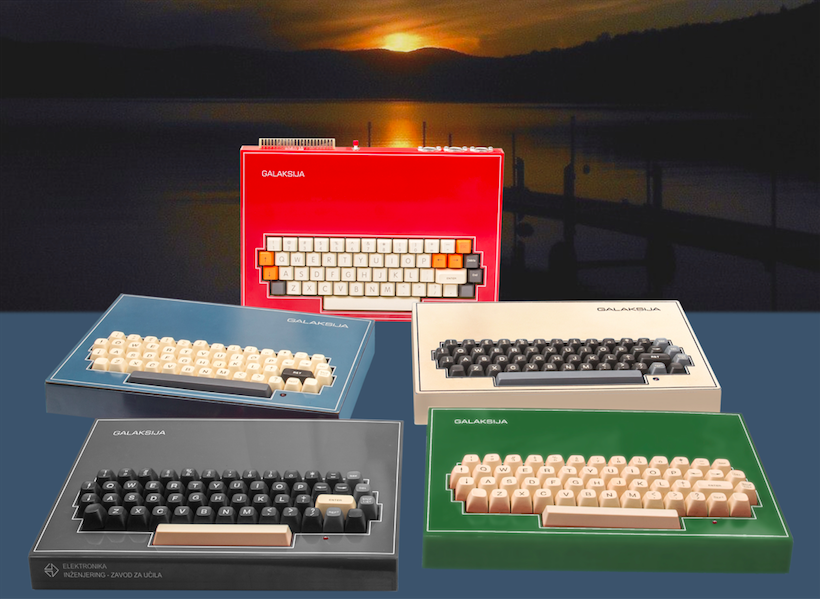
In the summer of 2020, a number of stories about Galaksija –the famed “first Yugoslav microcomputer”– came out. There was the Tribune piece that connected the Yugoslav computing industry and the development of Galaksija to the Tito-Stalin split in 1948. A number of articles were published about the Galaksija documentary currently in post-production and the crowdfunding effort around it. These stories, along with a few Twitter threads, piqued my interest. Despite working in tech and years of interest in the history of computing, I realized how little I knew about the Yugoslav domestic computer industry and culture of my (former) country. Hence I embarked on a journey to research this topic by attempting to build one of these early microcomputers, and to read as much documentation and original sources I could find. What follows are personal impressions and notes. Through this process I encountered a number of other fascinating stories that require additional research — this is an early draft of perhaps a larger project exploring Yugoslav tech heritage and its cultural impact.

Most articles about Galaksija start with a bold statement: Galaksija was Yugoslavia’s first computer! While that’s an understandably effective way to get the reader’s attention, it’s plainly false – Galaksija was definitely not the first, and it actually came out quite late. Released in 1984, it was one of later Yugoslav computers. However, this framing is understandable – Galaksija was by far the most successful domestic computer in terms of cultural impact and name recognition. But this framing of “the first” obscures what I think is the really fascinating thing about Galaksija: it was a uniquely anachronistic computer that should not have existed were it not for the specific circumstances of the late Yugoslav socialist state. After months of research, I think that what makes Galaksija unique is how it successfully overcame strict bureaucratic rules through means of technical design, and then it helped change those rules. Combined with an incredibly successful publishing effort in Računari u vašoj kući magazine, in the course of a year Galaksija reached the homes of thousands of Yugoslavs, and educated tens of thousands more about home computing. Moreover, within the same year, the strict customs limitations that prompted its design were relaxed – a significant policy change which Galaksija certainly influenced. Voja Antonić, Galaksija’s designer, makes a similar argument in his autobiographical article Hacking the Digital and Social System.
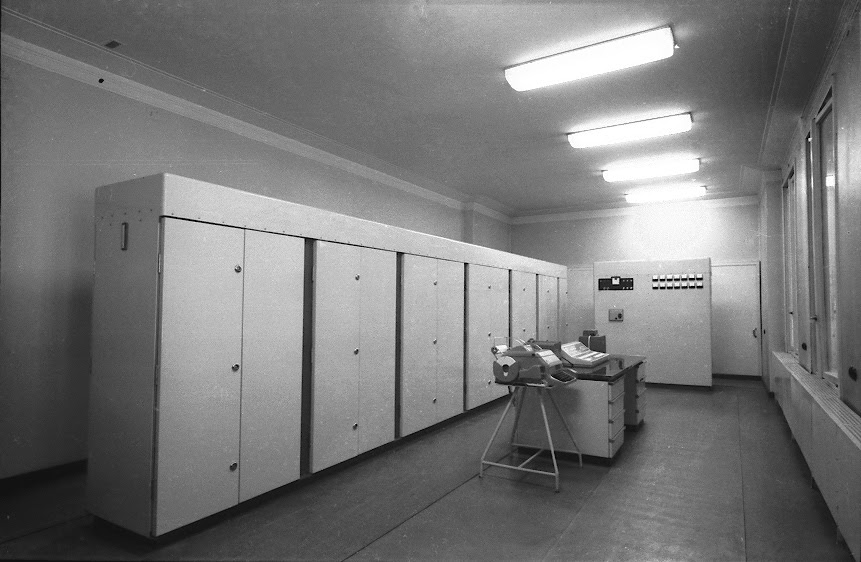
But let’s take a step back! Institute of Nuclear Sciences Vinča and the Mihajlo Pupin Institute, a University of Belgrade research institute, developed the first Yugoslav digital computer CER-10 (Cifarski Elektronski Računar, “Digital Electronic Computer”) in 1960. CER-10 was a vacuum tube, transistor and electronic relay based mainframe computer. It was initially deployed at the Tanjug News Agency, and was soon followed by a series of CER models released through 1975 and used by state institutions and companies, banks and the military. However, despite the early entry into the computing industry, Yugoslavia abandoned its domestic mainframe development, and by the mid-70s shifted to importing IBM and Honeywell models (Ei-Niš even manufactured Honeywell H6000 mainframes under license).

In 1971 Intel released the 4040, the first commercially available 4-bit microprocessor, followed by the 8-bit 8080 in 1974. It was soon followed by Motorola 6800, MOS 6502 and Zilog Z80 — by the mid 1970s computers utilizing 8-bit CPUs like Altair 8800 and the Apple I started the home computer era. Despite the early mainframe efforts, it took a while for Yugoslav companies to start producing microcomputers. Unlike the widespread import of mainframe machines from the West, strict customs rules significantly limited access to popular microcomputers like the Sinclair ZX-80 and ZX-81, cheap home computers that were accessible to many Western European families. This is where the story gets murky – and incredibly interesting! For items that couldn’t be obtained at home, shopping abroad was a very common thing for Yugoslavs, especially the middle class. Two popular destinations were Graz in Austria and Trieste in Italy. The practice –allowed and often encouraged by the authorities– was one of the many perks of Yugoslavia’s unique geopolitical position. Unlike the citizens of other European socialist states, Yugoslavs had largely unimpeded access to the West. Shopping abroad made them feel like they were a part of an increasingly global consumer culture, but it also provided opportunity to obtain new technologies like VCRs and camcorders, and most importantly – computers. However, there were limits.

The limits were regulatory, but also financial. You could only import DM 50 (Deutsche Marks) worth of goods, so people smuggled stuff all the time. There were no computers available for less than DM 50, but smuggling was a national sport by this point – you might get a ZX Spectrum along with some Levi’s jeans in Trieste (despite Levi’s literally making jeans in Yugoslavia, but I digress). Or perhaps a relative working abroad in Germany might bring one. While smuggling was easier for Yugoslav citizens closer to the Western borders with Austria and Italy, computers were still largely inaccessible to most Yugoslavs. Additionally, it was difficult to learn about computers in the first place. Until 1984 there were no computer magazines – early hobbyists would have to get publications like the American BYTE magazine the same way they would get their computers – from abroad.

It’s commonly assumed that the Yugoslav authorities didn’t allow import of microcomputers in order to protect the domestic microcomputer industry. Perhaps a more likely explanation is that by the early 80s the Yugoslav economic crisis and the significant bureaucratic and institutional rot affected the state’s ability to adapt to new circumstances the same way it did in earlier years. It would far exceed the scope of this project to analyze economic policies and collapse of the Socialist Federal Republic of Yugoslavia, but this is a good intro if you’re interested. After a few decades of huge improvement in standard of living, Yugoslavs experienced rapid stagnation and reduction by the 1980s. This was particularly manifested in inflation which would reach record heights in the late 80s, and “FR Yugoslavia” (Serbia and Montenegro) would trump even those in the 1990s. However, for a relatively stable socialist economy until then, inflation of the early 80s was hugely disruptive.
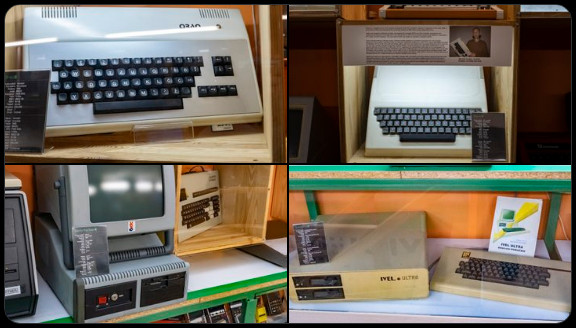
By 1984, when Galaksija was released, a few Yugoslav companies dabbled in production of microcomputers, mainly for use by state institutions and companies, or for education. Some of the computers that came out around the same time as Galaksija were:
- Lola 8, an Intel 8085A based computer made by Ivo Lola Ribar, a manufacturer of heavy machine tools named after a Partisan hero
- Galeb and Orao, developed by Miroslav Kocijan and manufactured by PEL Varaždin,
- Partner, manufactured by Iskra Delta
- Ivel Ultra, an Apple II clone designed by Branimir Makanec and manufactured by Ivasim elektronika
- Pecom 32/64, manufactured by Ei Niš
None of these achieved particularly widespread personal use – they were prohibitively expensive for individuals to purchase and were often produced in small quantities. Since they weren’t widespread in home use, there was limited software, and no community. This is something that took me a while to understand – at the time, most computers were not compatible with each other, so software had to be developed specifically for every model. Communities formed around specific machines. While none of these computers achieved the widespread recognition Galaksija had, the circumstances of their manufacturing are fascinating: they were often produced by companies that had no previous connection to computing. Famously, to manufacture the Orao, PEL Varaždin produced wicker baskets for export to offset the cost of importing parts for their computer (another import regulation intended to keep import deficit low and bring foreign currency into the country).
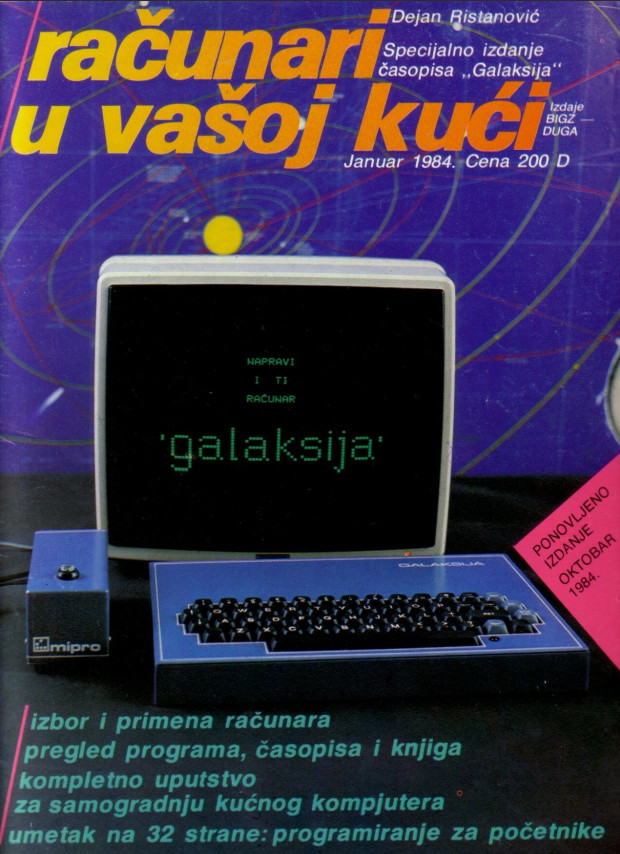
Galaksija’s origin story is legendary at this point: Voja Antonić, an engineer from Belgrade, came up with the idea for a DIY microcomputer while on honeymoon in Montenegro. This wouldn’t be his first computer – he had already designed another one by this point – the EL-82 for Elektronika inženjering. Around the same time, the 21 year old Dejan Ristanović was working on a special edition of Galaksija popular science magazine which would focus solely on computers. Računari u vašoj kući (Computers in your home), the special edition of Galaksija magazine, was supposed to come out in the fall of 1983. However, in early summer Zoran Vasiljević introduced Dejan and Voja, and they decided to combine their efforts: Voja would complete the design of the (then still unnamed) DIY computer, and Dejan would include the instructions in Računari u vašoj kući.
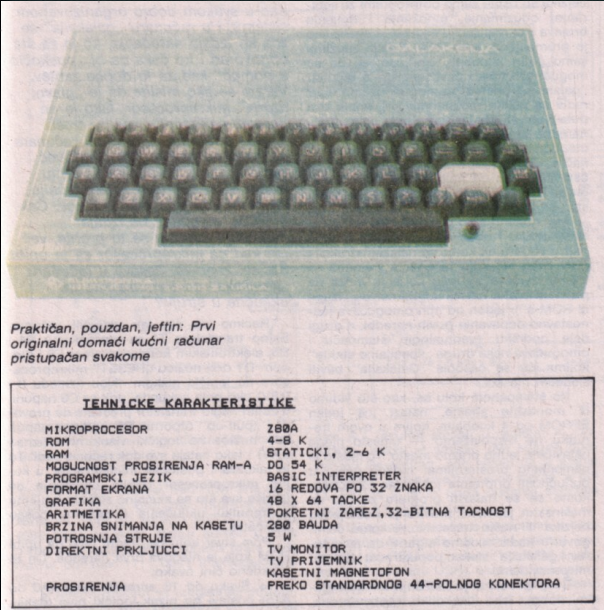
The project quickly exceeded this limited scope. They worked through the fall to finalize the computer, writing the miniscule 4KB ROM capable of running the computer, generating video on the Z80A CPU and featuring a very limited BASIC interpreter. The PCB was single sided, requiring a total of 119 wire jumpers, but lowering the cost significantly and making it simple enough to produce at home if necessary. Finally, the Z80A CPU ran at 3.072 MHz and the board featured 3 sockets for 6116 static memory, allowing for a total 6KB of RAM (expandable up to 54KB with an extension board). Space was made on the board for a second EPROM chip, so Galaksija was designed to be software upgradable.
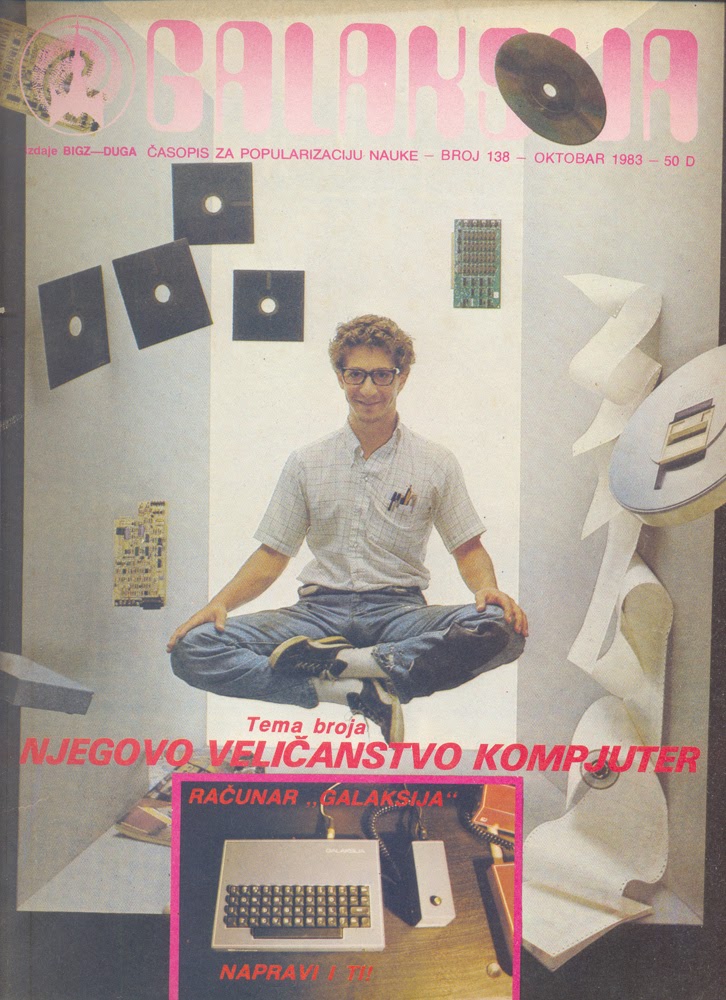
But Računari u vašoj kući went a step further – in addition to providing instructions, schematics and documentation necessary to build this computer, they also organized a supply and distribution chain! In the October 1983 issue of Galaksija magazine they introduced the project and released a questionnaire asking their readers if they would like to order a DIY kit. They expected a few hundred requests at most, but even this preliminary questionnaire exceeded 1000 orders (You can find this questionnaire on page 62 of Galaksija issue 138).

So, how does a magazine organize a supply and distribution chain for an affordable DIY computer in a country with strict customs rules? Let’s take a look at how a Računari reader in early 1984 could get their hands on components necessary to build a Galaksija:
- The “mechanical components”: PCB, keyswitches and keycaps. Institut za vakuumsku tehniku from Ljubljana made the keyswitches, Mipro and Elektronika from Buje made the PCB and the rest. You would order these parts directly through Računari for 5600 dinars.
- The ICs: these include the Z80A CPU, 7400 series logic ICs, RF modulator, the crystal and 3 IC sockets. Sold through Microtechnica in Graz, Austria for 1660 Austrian schillings. Ordering was coordinated so that no single package exceeded 1500 dinars. The instructions are fascinating: you would first write a letter to Microtechnica, they would send you an invoice (this is all through mail), you would then go to a bank to send the money, and then wait. You could pay by Amex, Diners, Eurocard or Visa. I’m not sure how widespread these cards were.
- The EPROMs: Galaksija used 2732 and 2716 ROMs to store the OS and characters. Per the ordering instructions, folks who ordered the ICs from Microtechnica would receive their EPROMs already programmed. It’s unclear if they were included in that 1660 schilling price. But the EPROMs would come from Belgrade, where Voja Antonić programmed them. Računari offered to program EPROMs for folks who obtained them independently completely for free! They would just need to send them in with a pre-stamped envelope.
- Passive components: there was no mention of ordering more common electronics parts like capacitors and resistors. I assume that those were available locally in stores.
For folks who weren’t ready for DIY, and for use in schools, Elektronika inženjering and Zavod za udžbenike i nastavna sredstva made pre-built Galaksijas. These weren’t ready yet when Računari came out, but eventually many schools received these factory built Galaksijas.
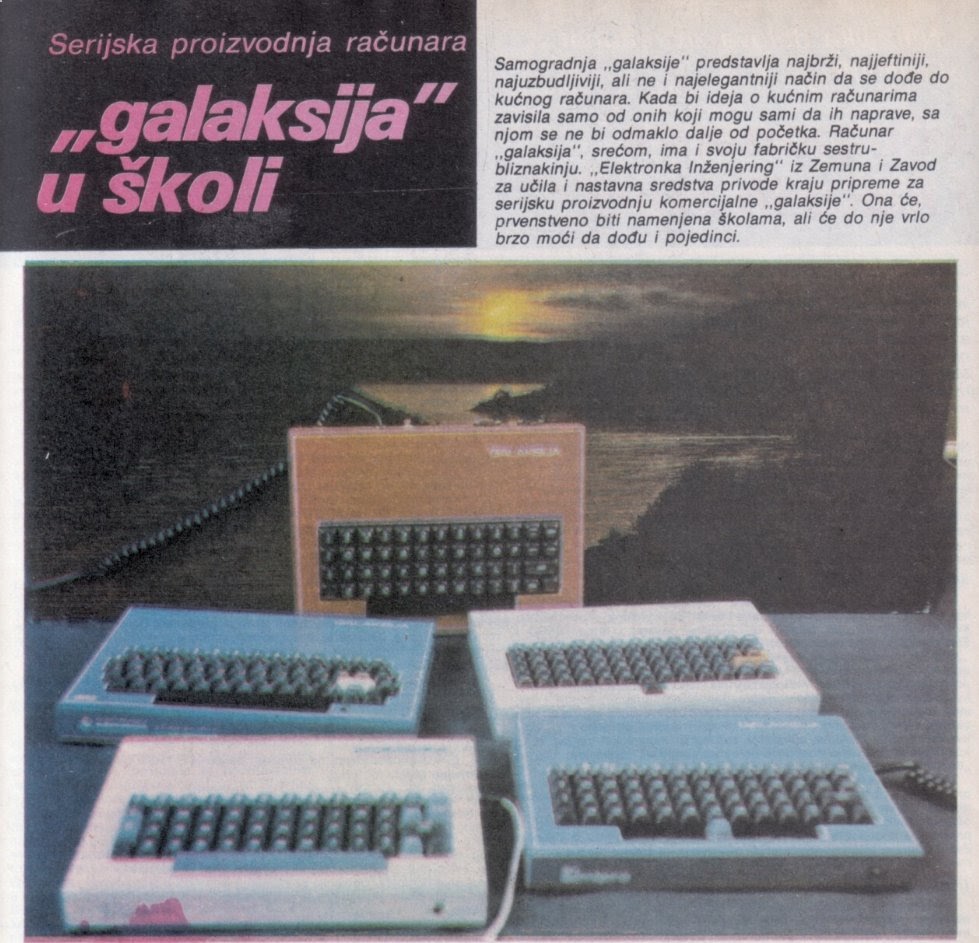
The decision to hold off on publishing Računari in the fall, and instead to work with Voja to include the Galaksija DIY guide was incredibly important for Galaksija’s success, but it also helped start the Yugoslav computer publishing industry. Before Računari there were random articles in newspapers and magazines. By 1985 there were computer monthlies like Moj mikro and Svet kompjutera,
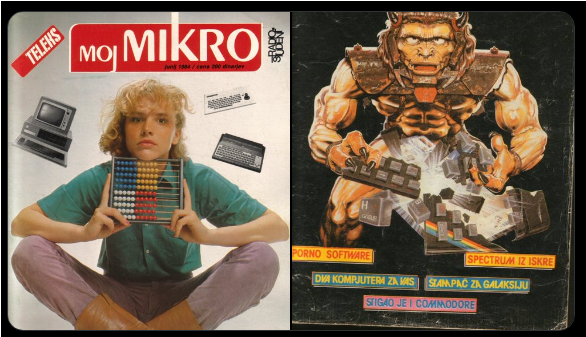

Dejan’s story really resonates with me, because he is someone who both understood computers but also how important they would become. He also understood and excelled in communication – publishing that first edition of Računari reached tens, if not hundreds of thousands of readers. In the late 80s he founded one of the earliest and biggest bulletin board systems in Yugoslavia – Sezam BBS. He wrote for Računari u vašoj kući for many years, and then started PC Press magazine. Dejan’s website is a great resource on all things Galaksija, Računari and other 80s computer projects, as well as his later work.
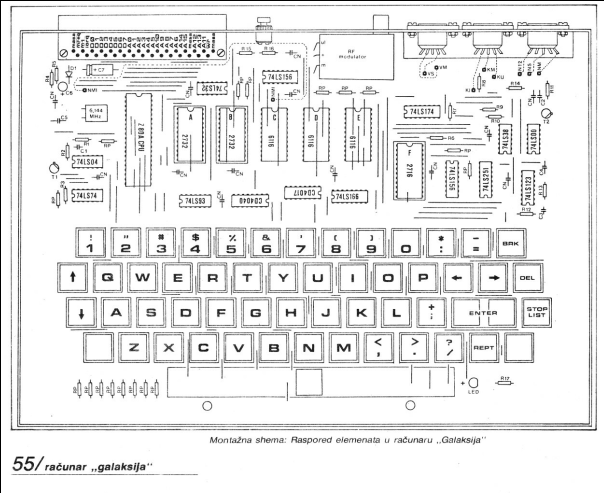
Računari u vašoj kući issue 1 hit the newsstands in late December 1983 and the initial release of 30 000 copies quickly sold out. Eventually, over 120 000 copies were sold after 4 re-prints. Instead of a few hundred, over 8000 people ordered the kit or sent their EPROMs in to be programmed. Galaksija was immensely popular, and even the people who didn’t end up making one had an opportunity to learn computing basics. Ristanović included a series of articles on choosing your first computer, with reviews, specs, benchmarks and comparisons of the popular 8-bit machines of the time: ZX Spectrum, Commodore 64, Apple II. Even the IBM PC and PCjr were included – the future was just around the corner, but for now all the attention was on Galaksija. The issue included an article explaining how computers worked and what they could be used for – at the time people still didn’t know what uses computers had at home. A large section was focused on games – the original home computing killer app. Along with the Galaksija DIY guide –which included the schematics, parts list, step-by-step instructions and even the guide for making your own RF modulator and logic probe– there was also an extensive intro to programming in BASIC. While a number of programs were eventually released for Galaksija (mostly games), for many people it was their first opportunity to experiment with programming – first in Galaksija’s simple BASIC, and later on in the Z80 machine language.
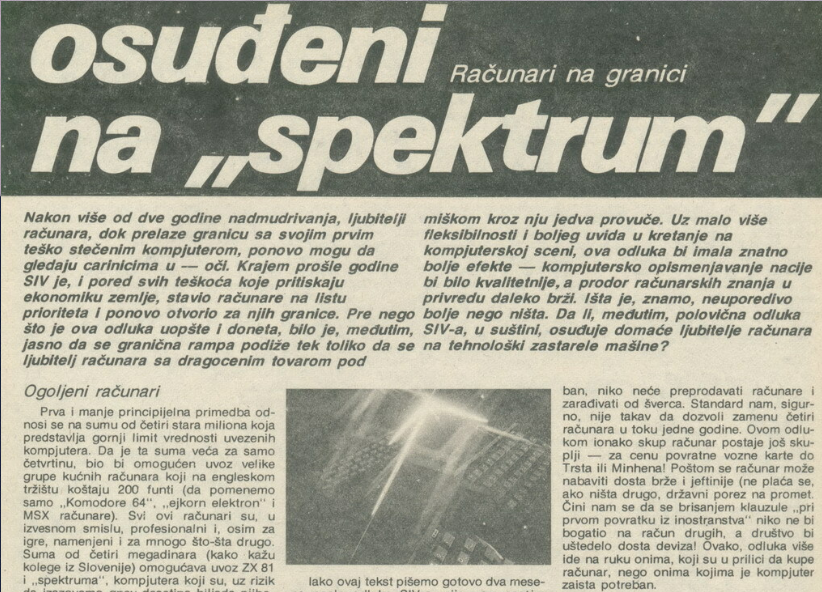
The rest is history. Even though the delivery of kits suffered many logistics issues –including the global static RAM price increase of 1984– by the end of the year thousands of households had a Galaksija. Računari u vašoj kući soon split from Galaksija magazine into an independent computer monthly, and other magazines like Svet kompjutera followed the development of Galaksija software and hardware expansions. But ironically, Galaksija was a victim of its own success. By late 1984 the SIV (Federal Executive Council) passed a new customs regulation that significantly relaxed the customs limit and explicitly allowed import of microcomputers. Per the February 1985 issue of Računari u vašoj kući, the regulation still didn’t allow mail ordering of complete computer systems and many machines like the Commodore 64 were still too expensive according to the rule, but popular ZX-81s and ZX Spectrums could now be freely bought in Graz or Trieste and brought home without additional anxiety at the border.
By the late 1980s Yugoslavia was rapidly disintegrating, and the time of the 8-bit home computer was over – the IBM PC, presented as just another option among many in the original Računari computer comparison, was quickly becoming the personal computer standard. However, Galaksija played a unique and important role in popularizing computing and raising a whole generation of programmers and IT professionals. While it was mostly forgotten for almost 30 years, Galaksija has seen a huge resurgence in interest recently. In Tribune, Michael Eby speculates that Galaksija resonates so much with us today because it “embodies a destratification of today’s technological hierarchy, a tacit ideological assertion that computing machinery should be for the masses, cheap and available to everyone, and that neither money nor technical know-how need be barriers to entry”. While this claim certainly resonates with me, after researching this history in detail I have to admit that looking back we may be projecting some of these qualities on to this wonderful little computer. On the one hand, it is true — Galaksija was designed and distributed to the masses by Voja, Dejan and many others involved in the process. The care, solidarity and absolute lack of financial interest in this immensely successful project seems completely incompatible with our understanding of the tech industry in 2020. But the particular role Galaksija played –getting around bureaucratic rules of a socialist state and popularizing computing– ultimately negated these qualities – as soon as these rules were relaxed, the market got quickly dominated by Western produced models.
However, maybe this kind of projection is exactly what we need right now. Going through the process of building a Galaksija and researching its history helped me develop a completely different way of relating to a computer. By following these 40 year old DIY instructions I developed a uniquely personal relationship to this tiny board of chips and wires I put together. My Galaksija is truly a personal computer — it’s different from all the other ones, and I know it inside out (even though it took me an embarrassingly long time to get it working). While I don’t think we should all go back to making our own computers (although passing Right to Repair laws should be a priority!), I do wonder if there are other ways we can lay claim to the technologies we use – to transcend the cycle of perpetual consumption and waste generation imposed on us through planned obsolescence. For me, learning this history is the first step.